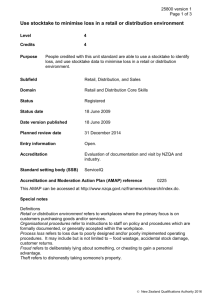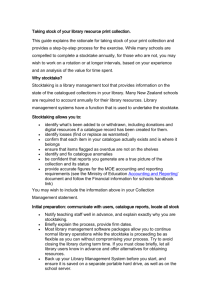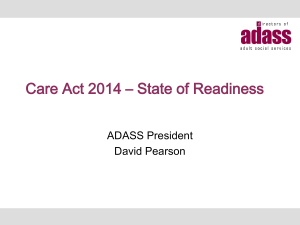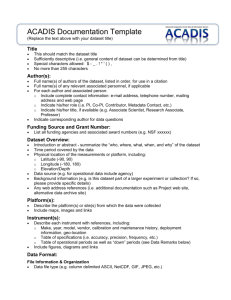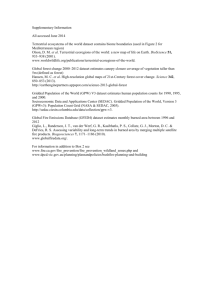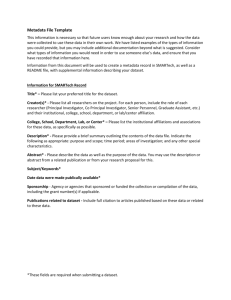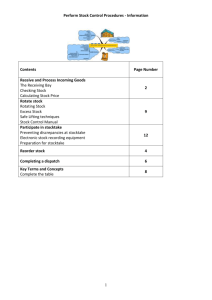What should be included in the stocktake of environmental
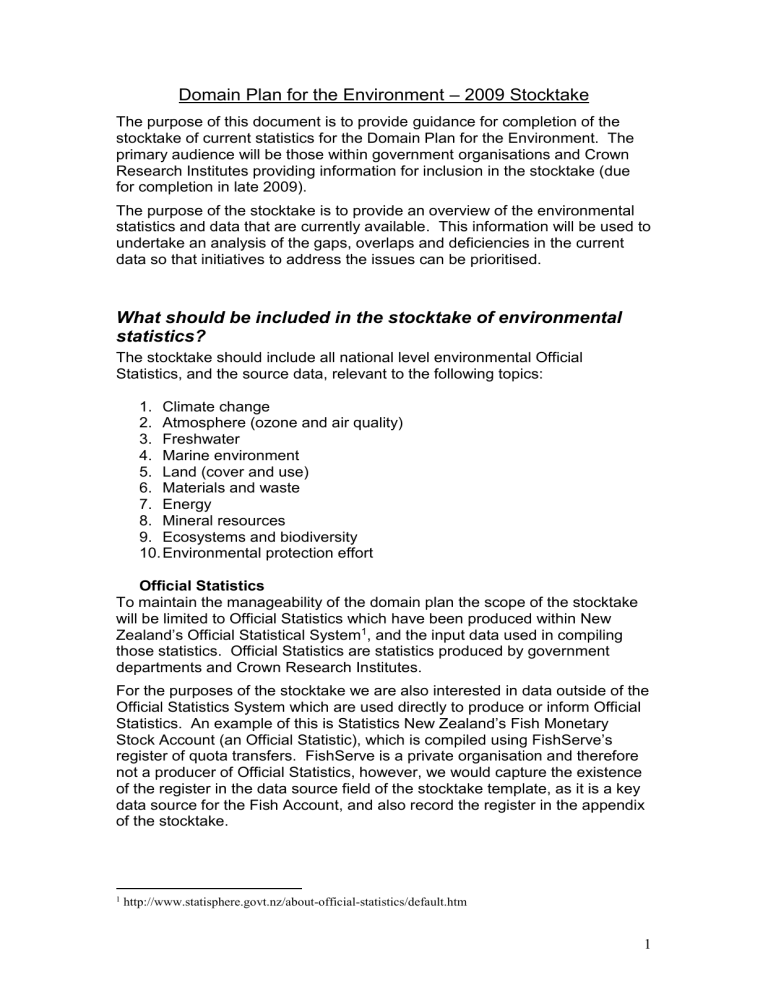
Domain Plan for the Environment – 2009 Stocktake
The purpose of this document is to provide guidance for completion of the stocktake of current statistics for the Domain Plan for the Environment. The primary audience will be those within government organisations and Crown
Research Institutes providing information for inclusion in the stocktake (due for completion in late 2009).
The purpose of the stocktake is to provide an overview of the environmental statistics and data that are currently available. This information will be used to undertake an analysis of the gaps, overlaps and deficiencies in the current data so that initiatives to address the issues can be prioritised.
What should be included in the stocktake of environmental statistics?
The stocktake should include all national level environmental Official
Statistics, and the source data, relevant to the following topics:
1. Climate change
2. Atmosphere (ozone and air quality)
3. Freshwater
4. Marine environment
5. Land (cover and use)
6. Materials and waste
7. Energy
8. Mineral resources
9. Ecosystems and biodiversity
10. Environmental protection effort
Official Statistics
To maintain the manageability of the domain plan the scope of the stocktake will be limited to Official Statistics which have been produced within New
Zealand’s Official Statistical System 1 , and the input data used in compiling those statistics. Official Statistics are statistics produced by government departments and Crown Research Institutes.
For the purposes of the stocktake we are also interested in data outside of the
Official Statistics System which are used directly to produce or inform Official
Statistics. An example of this is Statistics New Zealand’s Fish Monetary
Stock Account (an Official Statistic), which is compiled using FishServe’s register of quota transfers. FishServe is a private organisation and therefore not a producer of Official Statistics, however, we would capture the existence of the register in the data source field of the stocktake template, as it is a key data source for the Fish Account, and also record the register in the appendix of the stocktake.
1 http://www.statisphere.govt.nz/about-official-statistics/default.htm
1
National Coverage
The scope of the stocktake will be limited to statistics that can be used to build a national picture. For example, a database of water quality records from across New Zealand would be included, but a database of water quality records for just the Central Otago region would not.
Primary / Secondary Environmental Statistics
The Domain Plan for the Environment will utilise the Driving force-Pressure-
State-Impact-Response (DPSIR) model to provide a framework for analysis.
The stocktake will therefore seek to capture Official Statistics and other relevant environmental data that describe a situation directly relating to an environmental resource, pressure, or state that have been collected primarily for this purpose.
Secondary statistics, such as population data, that provide information on a pressure on the environment, but which are not collected primarily for that purpose, will be recorded but only in an appendix to the stocktake.
Other information not to be included in the stocktake
Research reports, previously compiled stocktakes, lists of databases or metadata in any storage formats, planned or incomplete work and models are out of scope for the stocktake. We are also primarily interested in data that is being actively maintained, however if any valuable dataset is not currently being maintained due to resource constraints a template should be completed for that dataset.
Templates for the stocktake of information sources
The templates below should be used when contributing to the stocktake of information sources for the environment domain. It is important to fill in all the fields as this will assist decision making during the gap analysis phase of the domain plans ’ development. The completed templates will also be published as part of the finalised Domain Plan for the Environment. Within the environmental domain there are relatively few surveys/censuses of individuals or enterprises that will appear in the stocktake of information sources and for that reason a separate template has been provided (please see below).
One of the key aims of the domain plan is to increase knowledge about the current availability and use of data. Ideally, the linked flow of environmental information from repositories of direct measurements to the summary statistics that appear in reports will be identified. For this reason the general information template includes an “information source” field. There should be a separate template completed (if it does not already exist and fits the criteria for inclusion) for each source of information for all reports and derived statistics.
2
Notes on stocktake template forms
Template for General Environmental Information
Topic: In order of relevance enter the environmental domain topics that this information informs, e.g. climate, energy (see bullet points on page 1 for the list of topics).
Information 2 type: This field will assist in the identification of linked flows of information and will enable multiple uses of primary data to be identified.
While there is no intention to create a classification for environmental information here, the information given should reflect how the data is collected, its storage, and if relevant its dissemination. Information types appearing in the stocktake include:
Administrative data
database of direct measurements
dataset/database of direct measurements including modelled information
statistical dataset
derived statistics
reports
integrated database (linked searchable databases)
Further information on the information types are given at the back of this document.
Information/Data custodian: Name the agency that holds and maintains the information or data in the format named above.
Information source: For derived statistics and reports enter the information source/sources i.e. the title of the information. Where the information named here fits the criteria for inclusion in the stocktake for the environmental domain a separate template form should be created if this has not already been done.
For example the information source for the Fish Monetary Stock Account is
Fishserve’s quota register.
Note: For databases/datasets of primarily direct measurements and administrative data enter NA. This is because the source for these is individual records of measurements or transactions.
Information source type: For derived statistics/reports enter the information source/sources type (from the list above). Again using the Fish Monetary
Stock Account as an example, the information source type of FishServe’s quota register is administrative data.
Note: For databases/datasets of primarily direct measurements enter NA.
2 The term ‘information’ as used in this document refers to the name or label of a given item that appears in the stocktake whereas the term ‘data’ will generally refer to a collection of records.
3
Frequency: How often is this information updated/published.
Quarterly (or more often)
Annually
Biennially
One off
Or ad hoc – list dates of previous updates/publications
Reference period: What period does the dataset/publication/register cover, i.e. 1972
–2006.
Objectives: Briefly, why is this information collected and what is it used for?
Data collected: What are the key variables extracted or able to be extracted from the information? Include notes about coverage and collection units where relevant. Using the freshwater organisms database as an example the data collected field would include:
Presence/abundance of algae, macrophytes, invertebrates and fish.
The coverage extends to most of NZ with a large network (thousands) of sites.
Data access: Is the information freely disseminated in the form named above? Are any protocols in place for sharing of or access to the data?
Further information: Don’t include names here, please provide one or both of the following:
a link to the webpage where the latest releases of the output appears
an email address for the information / enquiries department at the custodian organisation or unit.
Template for surveys / census
Topic: In order of relevance enter the environmental domain topics that this information informs.
Information type : Select from: survey census
Data custodian: Name the agency that holds and maintains the response records and derived datasets
Collection unit: Name collection unit e.g.:
Dwelling, household
Individual
Household
Enterprise or other group
Coverage: Select from:
National
All NZ regional authorities
Or describe other coverage i.e. Auckland, Wellington and Christchurch urban areas
4
Units surveyed: How many units were selected from the survey or target population
Frequency: i.e. five-yearly, annually etc. If ad hoc
– list dates of previous survey cycles
Reference period: What period does the survey/census dataset cover, i.e.
1972
–2006.
Objectives: Briefly, why is this information collected and what is it used for?
Data collected: What are the key variables extracted or able to be extracted from the response information?
Data access: Is a report or dataset of the survey responses freely disseminated? Are any protocols in place for sharing of or access to the unit record data?
Further information:
Don’t include names here, please provide one or both of the following:
a link to the webpage where the latest releases of the output appears
an email address for the information / enquiries department at the custodian organisation or unit.
Blank Templates
Title: General Environmental Information
Topic
Information Type
Data Custodian
Information source
Information source type
Frequency
Reference period
Objectives
(what the purpose is)
Data collected
(key variables, outputs)
Data access
Further information
5
Title: Surveys / Census
Topic
Information Type
Data Custodian
Collection unit
Coverage
Units surveyed
Frequency
Reference period
Objectives
(what the purpose is)
Data collected
(key variables, outputs)
Data access
Further information
Information types
Administrative data
Database of direct measurements
Database/dataset of direct measurements including modelled information
Integrated database
Dataset
derived statistics
Reports
Some information types may fall into one or more categories, if this is the case those compiling the stocktake forms are requested to use the type description that they feel best describes their information.
It will also be useful to be able to isolate the information with a spatial component and this should also be noted in the information type field.
Administrative data is data that is collected as a by-product of another, usually regulatory process. As an example builders and renovators are required to get planning permission for most building work done in New
Zealand and the record of this consents process can be used to provide information on the level and value of building activity that is occurring in the economy. Administrative data is used in many areas of SNZ, e.g.
birth and death data from the Department of Internal Affairs is used in population projections.
Database of direct measurements database is an application that manages data and allows for fast storage and retrieval of that data. Relevant information will generally be added to the database on an as available basis or in batches. Direct measurements refer to observations, or results that are measured, usually in the field, an example being the National Climate
Database or the Land Cover Database.
6
Database/dataset of direct measurements including modelled information often direct measurements are taken at points considered representative and these measurements are inputted into a model to build up an estimate for the whole system. This information may then be extracted from the database in the form of a dataset to create an estimate for a given area or point in time. An example is the dataset produced by NIWA for
Statistics New Zealand’s use in the compilation of the water account. This dataset contains information based on point measurements taken from a network of monitoring stations and modelled results to account for sites where measurements are not taken.
Integrated database (linked searchable databases): Often research organisations will use the same database design and platform and then design search tools that can search all of the databases for a single topic simultaneously. The resulting entity will often be a named product in its own right, an example being the Geophysical properties of New Zealand Database maintained by GNS.
Dataset in addition to the output from a database the term dataset refers to the unit records behind any statistical result or total. For example confidentialised unit records from a survey or census may be made available to researchers in the form of a statistical dataset. A dataset differs from a database in that it is not constantly being updated i.e. its individuals cells will add to a, usually pre-published, total for a given point in time.
Derived statistics the term derived statistics refers to a summary statistic, or indicator, that is derived from more than one source. An example being the economic indicator quarterly GDP, the sources QGDP are compiled from include the AES survey, CFIS data, the local authority census and trade data.
The derived statistic might then be stored in a database or outputted into a dataset and may well be released in a report format.
Reports: refers to a statistical result that is disseminated in the form of a written report. Reports may draw on information from any of the storage formats named above and will usually also provide background information, and methodology. Often a report will be released with accompanying data tables.
7
